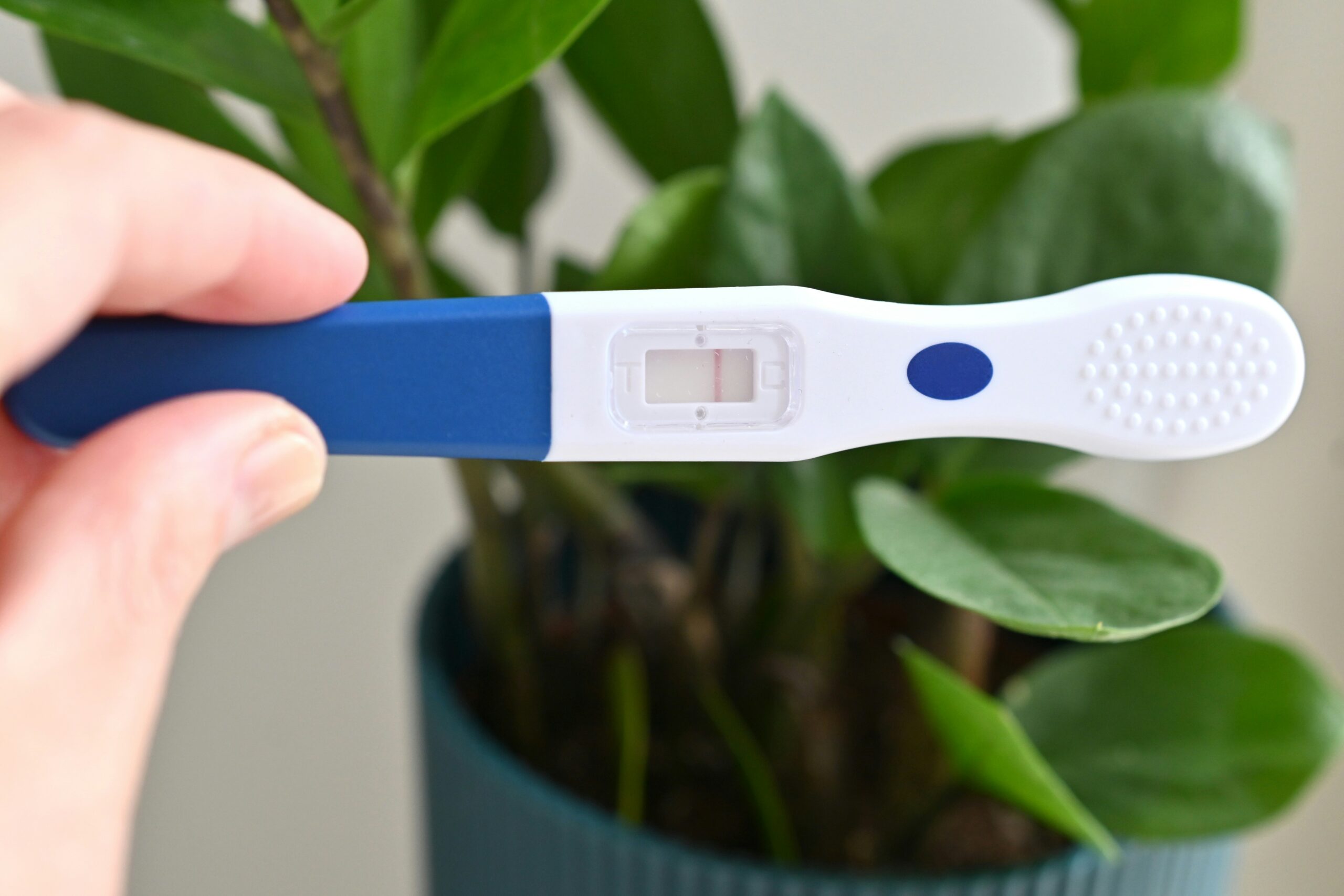Twelve years ago, I began living in two-week increments. Am I pregnant or not?
I was 32 years old and already a mother of two. After the shock of a miscarriage with my third pregnancy, I discovered that this experience of TTC (trying to conceive) was going to be wildly different. I felt not only deep loss with the miscarriage but also an extreme drive to “fix the problem.” As I tried to do just that, a new reality came to light: secondary infertility. It changed everything, from my personal life to my business and, ultimately, my life’s mission.
No woman expects or plans to struggle with infertility. How could we when we’re still living under the pressure and guise of the fairytale: meet Prince Charming, have a magical wedding and effortlessly have babies? At 32, I had undiagnosed infertility, meaning my doctors couldn’t give me a reason for why I couldn’t get pregnant—or a solution It only compounded the shame and guilt I felt for my body not doing what it was “supposed” to do. I was immediately propelled into confusion and isolation, especially because the societal measuring stick said my life was right on track.
That “on-track” life took off in my 20s. I was married, planning to start a family and about to launch what is now a successful baby brand, Caden Lane. At 25 years old, I went to Mexico by myself, while newly pregnant with my first baby, to meet a manufacturer for product samples. My husband thought I was crazy, but I was fearless and determined. By the time I received the samples, I was even more pregnant—with terrible morning sickness—but that didn’t stop me from going door-to-door with retailers in the thick of the Texas summer heat.
By my late 20s, I had grown Caden Lane into a nationwide brand, and opened my first flagship retail store in Texas. I also welcomed my second daughter. My company and my work were quite literally a labor of love. So when I found myself 32 years old in the category of 1 in 5 women who will experience infertility in their lifetime, work was a soft place to land when I needed a distraction from the feelings of isolation and “what ifs.”
No one besides me and my husband knew about our struggles. I wanted this third baby so badly, and when I realized I wasn’t in control of my own body, it was gut-wrenching. I didn’t know how to ask for support or even what support would look like. In hindsight, I think if anybody had known what I was going through and had just hugged me, I would have broken down in tears.
As women, we tend to carry the burden by ourselves, even when we have a partner or trusting family and friends. And amid the heaviness, we carry on, which might mean attending a baby shower or a girls’ dinner where someone is celebrating a new pregnancy. It’s hard to sit there and hear those conversations and not get angry. Why is it so easy for her? And it’s so hard for me?
Even just 12 years ago, pregnancy loss and infertility were still fairly taboo subjects. There wasn’t the kind of community and open dialogue that we see today on social media. I remember joining an online message board on BabyCenter. Most of the conversation was straightforward—women talking about tracking their two-week wait or what shots they were taking. It wasn’t the open communication I needed, but it gave me some peace of mind to know that I wasn’t alone.
While I was holding it all together on the outside, I was navigating a complex emotional battle about what was, or wasn’t, happening on the inside. During the first year after the miscarriage, I was still trying to get pregnant naturally. At that time, over-the-counter tests and fertility-tracking apps were not the norm. So, like many in my shoes, I was obsessed with every detail of my body’s signals, from temperature checks to studying discharge for signs of ovulation.
Eventually, my husband and I decided to seek help. We saw a specialist who, unable to pinpoint the exact cause of the infertility, told me my age was a factor. Although 32 isn’t “too old” to have a baby, the truth is that the longer we wait to have babies, the harder it becomes. That still sits with me. I have two daughters and I would never want to tell them “Make sure you get pregnant early enough so you lower your chance of infertility.” My hope is, in the coming years, the medical and infertility fields will advance enough that my daughters won’t have these concerns.
My journey started with the typical course of treatment for infertility: countless rounds of testing and then IUI (intrauterine insemination). After two or three IUIs to no avail, we started IVF, where I administered hundreds of shots to myself.
The stress affected my marriage, and I hear that’s common. I was shouldering a unique burden—I was still the “face” of infertility, whether it was due to something in my body or my husband’s. Candidly, I felt slightly crazy between the meds and hormones, plus the testing and temping every morning. It’s a lot.
For a time, my life was an intricate dance of anticipation and anxiety, and then there was also guilt for feeling greedy. I already had two healthy babies. Why should I want more? But I did. In my heart, I knew I had another baby in me.
It was Christmas Eve 2011 when I was ready to take another pregnancy test. I remember going into the bathroom and then waiting for what felt like an eternity. Today we can watch TikToks of women taking their pregnancy tests. We see them looking in the mirror with cameras propped up saying, “It’s fine either way.”
We try to mentally prepare ourselves to not be disappointed. Those videos are so relatable because I remember doing the same thing, thinking, I can either take this test now and potentially ruin my Christmas, or I can wait.
But I couldn’t wait. I couldn’t sit with the questions any longer: Is that a twitch I feel? Are my breasts sore?
Then I saw the faintest line that I stared at for hours in different lights of every room in my house. It was an immediate relief, followed by a tidal wave of fear: What if it ends in miscarriage again?
We call Lila our “perfect frozen baby.” She was born in August 2012 from a frozen embryo on our second round of IVF. After giving birth, I knew my family was complete. There was one more birth, though:an unexpected gift. It came after a moment of shared experience between two women who went through hell.
A woman in my store was picking out newborn items, and she was crying. I went over and asked if she was okay. It turns out she was shopping for her best friend’s baby shower gift. She told me, “It’s just hard because I can’t get pregnant.”
We stood there for hours, sharing our stories. I told her about my doctor, and she ended up switching to him. She came back to the store to shop when she was pregnant. Today, her children are on the Caden Lane website. Her story felt like such a win—her win, but there was something beautiful in it for me, too.
That conversation is where my idea for the Conceive Fertility Foundation (CFF) was born. I desperately wanted to give back in a bigger way. CFF invests in the dream of motherhood, supporting women affected by infertility through education and grants.
Today, I see numerous women and their partners taking out second mortgages on their homes or going into massive credit card debt to become parents, and many can’t afford treatment at all. Infertility does not discriminate and CFF is how I can help make motherhood come true for many. We give back in two ways: Caden Lane gives back proceeds from its Conceive Fertility Foundation collection, and we also give our customers the option to round up or contribute. I had no idea that hardship would lead me to my greatest passion, but here I am.
Our goal at CFF is to help women start families without going broke. I’m grateful for the journey that has given me purpose, and I’m hopeful for a future that is kinder to women aching to be mothers.
Read more real-life stories by women who are breaking the stigma and changing the dialogue at the Miscarriage Movement.
Author
-

Katy Mimari launched Caden Lane nearly 20 years ago with a mission to celebrate the most important milestones of a mother’s life with colorful and timeless products that are “Designed By Moms For Moms.” Today, Caden Lane is a 9-figure business and one of the fastest-growing female-led companies known for newborn essentials, apparel, and personalized gifts. Since its inception, the brand has amassed a massive following with celebrities and hundreds of mega influencers often touting the latest prints and products. In 2022, Katy decided to give back in a big way with her sights set on making the dream of motherhood come true for many. Katy launched the “Conceive Fertility Foundation,” to help women struggling with infertility, a battle Katy also faced in growing her own family."
View all posts





